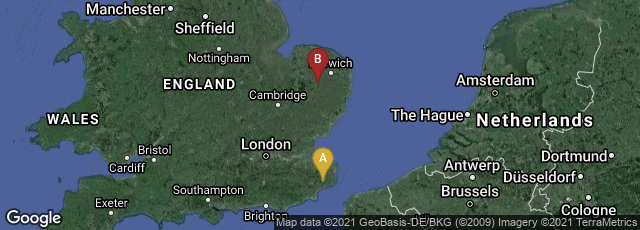Thrashing machines, an archaic term for threshing, as depicted in Jamieson, Dictionary of Mechanical Science...(London, 1827). This and the following page in Jamieson's book show how primitive the threshing machine mechanism remained at the time of the Swing Riots. Note that the machines were powered by horse or water and still required six men for their operation.


A: Elham, Canterbury, England, United Kingdom, B: Attleborough, England, United Kingdom
In 1830 agricultural workers in southern and eastern England engaged in the Swing Riots, a widespread uprising in protest of the mechanization of agriculture and other harsh conditions. With respect to mechanization, threshing machines, which had been increasingly introduced since the end of the 18th century, had gradually disemployed a very large number of agricultural workers, since before mechanization the labor-intensive threshing process had employed 25% of all agricultural workers.
"It began with their destruction of threshing machines in the Elham Valley area of East Kent in the summer of 1830, and by early December had spread throughout the whole of southern England and East Anglia.[1]
"The first threshing machine was destroyed on Saturday night, 28 August 1830 and, by the third week of October, more than 100 threshing machines had been destroyed in East Kent. As well as attacking the popularly hated threshing machines, which displaced workers, the protesters rioted over low wages and required tithes, destroying workhouses and tithe barns associated with their oppression. They also burned ricks and maimed cows.[1][2]
"The rioters directed their anger at the three targets identified as causing their misery: the tithe system, requiring payments to support the established Anglican Church; the Poor Law guardians, who were thought to abuse their power over the poor; and the rich tenant farmers who had been progressively lowering workers' wages while introducing agricultural machinery.[1] If captured, the protesters faced charges of arson, robbery, riot, machine breaking and assault.[3] Those convicted faced imprisonment, transportation, and possibly execution.[3]
"The Swing Riots had many immediate causes. Prof. J. F. C. Harrison believed that they were overwhelmingly the result of the progressive impoverishment and dispossession of the English agricultural workforce over the previous fifty years, leading up to 1830.[1]In parliament Lord Carnarvon had said that the English labourer was reduced to a plight more abject than that of any race in Europe, with their employers no longer able to feed and employ them.[4][5]
"The name "Swing Riots" was derived from Captain Swing, the fictitious name often signed to the threatening letters sent to farmers, magistrates, parsons, and others. He was regarded as the mythical figurehead of the movement.[6] ('Swing' was apparently a reference to the swinging stick of the flail used in hand threshing). The Swing letters were first mentioned by The Times newspaper on 21 October 1830[7]"(Wikipedia article on Swing Riots, accessed 12-2018).